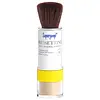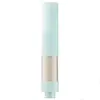Supergoop! (Re)Setting Mineral Powder SPF 35 Versus Tarte SEA Set & Protect Mineral Sunscreen Powder Broad Spectrum SPF 30
What's inside
What's inside
 Key Ingredients
Key Ingredients

 Benefits
Benefits

 Concerns
Concerns

 Ingredients Side-by-side
Ingredients Side-by-side

Zinc Oxide 24.7%
Cosmetic ColorantCalcium Aluminum Borosilicate
Silica
AbrasiveTrimethylsiloxysilicate
EmollientCalcium Sodium Borosilicate
Polymethyl Methacrylate
Lauroyl Lysine
Skin ConditioningPolyglyceryl-10 Pentaisostearate
EmollientBoron Nitride
AbsorbentTriethoxycaprylylsilane
Ethylhexylglycerin
Skin ConditioningNylon-6/12
AbsorbentSodium Dehydroacetate
PreservativeOlive Glycerides
EmulsifyingAscorbyl Palmitate
AntioxidantCeramide NP
Skin ConditioningIron Oxides
Zinc Oxide 24.7%, Calcium Aluminum Borosilicate, Silica, Trimethylsiloxysilicate, Calcium Sodium Borosilicate, Polymethyl Methacrylate, Lauroyl Lysine, Polyglyceryl-10 Pentaisostearate, Boron Nitride, Triethoxycaprylylsilane, Ethylhexylglycerin, Nylon-6/12, Sodium Dehydroacetate, Olive Glycerides, Ascorbyl Palmitate, Ceramide NP, Iron Oxides
Titanium Dioxide
Cosmetic ColorantVanilla Planifolia Fruit Extract
Skin ConditioningZinc Oxide
Cosmetic ColorantPolymethylsilsesquioxane
Silica
AbrasiveJojoba Esters
EmollientCaprylyl Glycol
EmollientAlumina
AbrasiveSodium Dehydroacetate
PreservativePhenoxyethanol
PreservativeVanillin
MaskingCaprylic/Capric Triglyceride
MaskingHexylene Glycol
EmulsifyingAluminum Dimyristate
Emulsion StabilisingTriethoxycaprylylsilane
Disodium Stearoyl Glutamate
CleansingMica
Cosmetic ColorantIron Oxides
Titanium Dioxide, Vanilla Planifolia Fruit Extract, Zinc Oxide, Polymethylsilsesquioxane, Silica, Jojoba Esters, Caprylyl Glycol, Alumina, Sodium Dehydroacetate, Phenoxyethanol, Vanillin, Caprylic/Capric Triglyceride, Hexylene Glycol, Aluminum Dimyristate, Triethoxycaprylylsilane, Disodium Stearoyl Glutamate, Mica, Iron Oxides
 Reviews
Reviews

Ingredients Explained
These ingredients are found in both products.
Ingredients higher up in an ingredient list are typically present in a larger amount.
Silica, also known as silicon dioxide, is a naturally occurring mineral. It is used as a fine, spherical, and porous powder in cosmetics.
Though it has exfoliant properties, the function of silica varies depending on the product.
The unique structure of silica enhances the spreadability and adds smoothness, making it a great texture enhancer.
It is also used as an active carrier, emulsifier, and mattifier due to its ability to absorb excess oil.
In some products, tiny microneedles called spicules are made from silica or hydrolyzed sponge. When you rub them in, they lightly polish away dead skin layers and enhance the penetration of active ingredients.
Learn more about SilicaThis ingredient is a preservative with antimicrobial properties. It is the sodium salt of dehydroacetic acid.
It is especially effective at preventing bacterial and fungal growth in low concentrations.
Triethoxycaprylylsilane is a silicone used to bind and stabilize ingredients.
As an emulsifier, it helps prevent ingredients from separating. This can help elongate the shelf life of products.
Triethoxycaprylylsilane is often used to coat mineral sunscreens ingredients to help give a better feel. It also helps reduce oxidative stress in sunscreens.
Learn more about TriethoxycaprylylsilaneZinc Oxide is a mineral broad-spectrum UV filter; it is the broadest UVA and UVB reflector approved by the FDA. It also has skin protectant and skin soothing properties.
Zinc oxide is one of the most effective broad-spectrum UV filters. It protects against UVB, UVAII, and UVAI. In comparison to its counterpart titanium dioxide, zinc oxide provides uniform and extended UVA protection.
Another great benefit? This ingredient is highly photostable so it won't degrade easily under sunlight.
A common myth is that mineral UV filters are widely believed to primarily reflect UV light.
However, modern research shows titanium dioxide absorbs UV radiation like chemical filters (~95% absorption & 5% reflection).
Zinc oxide has great skin soothing properties so you'll likely find this in sunscreens formulated for sensitive skin or babies/children. It is unlikely to cause "eye sting" like other sunscreen ingredients.
Regulatory agencies consider zinc oxide to be non-toxic and safe. It has also been shown to not penetrate the skin.
Unfortunately, this ingredient does leave a visible white cast. This is why mineral sunscreens are often less cosmetically elegant than chemical or hybrid ones.
In cosmetics, zinc oxide can be found in both non-nano and nano-sized forms. The nano version is used to reduce white cast and improve the texture of sunscreen formulas.
There are ongoing concerns surrounding nano-zinc oxide's impact on marine ecosystems and whether it can be absorbed into skin.
Regarding marine ecosystems and coral reefs, there is no conclusive evidence that any form of zinc oxide (or any other sunscreen ingredients) will cause harm. The science is still developing but many consumers are keeping a close eye on this issue.
Please note, many destinations have reef-safety sunscreen rules. For instance, the U.S. Virgin Islands advises all visitors to use non-nano mineral sunscreens.
There has also been some stir about whether micronized or nano zinc oxide has potential photoxicity and absorption through the skin/lungs.
An in-vitro (done in a test tube or petri dish) study demonstrated micronized zinc oxide to have potential phototoxicity. There's no need to fret; the EU Commission's Scientific Committee on Consumer Safety has stated, "The relevance of these findings needs to be clarified by appropriate investigations in vivo." Or in other words, further studies done on living organisms are needed to prove this.
Current research shows zinc oxide nanoparticles do not penetrate intact or sunburned skin. They either remain on the surface or in the outermost layer of dead skin (stratum corneum).
Zinc oxide is one of only two classified mineral UV filters with titanium dioxide being the other one.
Fun fact: Zinc has been used throughout history as an ingredient in paint and medicine. An Indian text from 500BC is believed to list zinc oxide as a salve for open wound. The Ancient Greek physician Dioscorides has also mentioned the use of zinc as an ointment in 1AD.
Learn more about Zinc OxideThis ingredient is a combination of red, black, and yellow iron oxide pigments. This combination of colors is usually found in foundation, because it results in a "skin" color.